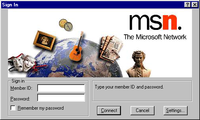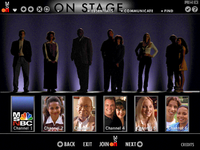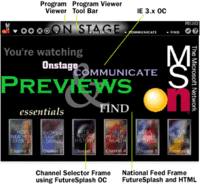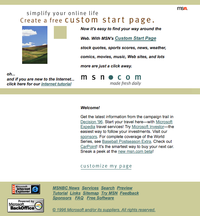- MSN
-
This article is about the Internet service provider and Internet portal. For the instant messaging service once called MSN Messenger, see Windows Live Messenger. For other uses, see MSN (disambiguation).
The Microsoft Network 
URL msn.com Commercial? Mixed Type of site Portal Registration Optional Owner Microsoft Created by Microsoft Launched August 24, 1995 Alexa rank  11 (November 2011[update])[1]
11 (November 2011[update])[1]Current status Active MSN (originally The Microsoft Network) is a collection of Internet sites and services provided by Microsoft. The Microsoft Network debuted as an online service and Internet service provider on August 24, 1995, to coincide with the release of the Windows 95 operating system.[2]
The range of services offered by MSN has changed since its initial release in 1995. MSN was once a simple online service for Windows 95, an early experiment at interactive multimedia content on the Internet, and one of the most popular dial-up Internet service providers.
Microsoft used the MSN brand name to promote numerous popular web-based services in the late 1990s, most notably Hotmail and Messenger, before reorganizing many of them in 2005 under another brand name, Windows Live. MSN's Internet portal, MSN.com, is currently the 11th most visited domain name on the Internet.[3]
Contents
MSN, the Internet service provider
MSN Classic
The concept for MSN was created by the Advanced Technology Group at Microsoft, headed by Nathan Myhrvold. MSN was originally conceived as a dial-up online content provider like America Online, supplying proprietary content through an artificial folder-like interface integrated into Windows 95's Windows Explorer file management program. Categories on MSN appeared like folders in the file system.[4]
Then officially known as 'The Microsoft Network,' the service launched along with Windows 95 on August 24, 1995. MSN was included with Windows 95 installations and promoted through Windows and other Microsoft software released at the time. Product support and discussion was offered through the MSN service, as well as information such as news and weather, basic e-mail capabilities, chat rooms, and message boards similar to newsgroups.
Open access to the World Wide Web was not originally included in the classic MSN service at the time of its initial launch, but Internet access was quickly offered through Microsoft's Internet Explorer web browser, which was available as a download from the MSN service or as part of the Windows 95 Plus! package.[4]
MSN 2.0
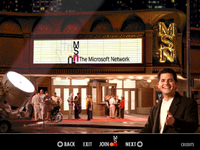 The MSN Preview was a mock premiere event, with host 'Michael'
The MSN Preview was a mock premiere event, with host 'Michael'
In 1996, in response to the increasing relevancy and rapid growth of the Internet, Microsoft renamed its existing MSN service to 'MSN Classic' and created a new version, called 'MSN 2.0,' which combined access to the Internet with web-based multimedia content in a new program known as the 'MSN Program Viewer.'[5] The service was promoted to existing MSN subscribers beginning October 10, 1996; the general release followed on December 10, 1996.[6][7]
Microsoft promoted MSN 2.0 with a series of advertisements and promotional materials describing the service with the phrase, "Every new universe begins with a big bang." The company offered the initial release of the new MSN 2.0 service on a CD-ROM that it sent to MSN subscribers in the fall of 1996. When inserted, the CD-ROM opened to the ambitious and flashy 'MSN Preview,' an interactive video-based experience that introduced current and prospective subscribers to the new version of MSN and described the features of the MSN 2.0 software.[8]
The MSN Preview was formatted as a guided tour of a mock premiere event for the new MSN. It was hosted by a witty and sarcastic character named 'Michael' who welcomed viewers outside of a theatre and then guided them through the theatre to meet several other characters, each of whom represented one of the channels of MSN 2.0's 'On Stage' area, which was designed as the main platform for interactive multimedia content in MSN 2.0.[8]
A handful of uncredited actors appeared in the MSN Preview, including then-unknown actress Anna Faris,[9][10] who represented 'Channel 5,' which was described as "media, zines, attitude"; it was targeted at college-age members. The preview also included its own jazz and pop music loop that played during the installation process.[11]
Once installed, members accessed MSN content through the MSN Program Viewer, which was essentially an animated, stylized and streamlined interface on top of an Internet Explorer 3.0 web browser. When members signed in, they would be presented with several different 'Channels,' which were essentially categories for the various types of content available on MSN. These channels included new services such as msnbc.com, a news web site that began as a partnership between Microsoft and NBC; and Slate, an online magazine focused on politics and current events; both were available to all Internet users, and both are still active, many years later.[6]
Interactive multimedia content was presented in a TV-like format, dubbed MSN shows, as part of the 'On Stage' section. The many shows and sites included an interactive online nightly game show called 'Netwits,' a snarky web site addressing women's issues called 'UnderWire,' and a regular celebrity interview and web-surfing session called 'One Click Away.' These new destinations supplemented web-based MSN services such as CarPoint and Expedia, which were branded as 'Essentials.' An additional 'Communicate' section was based around e-mail, chat rooms, and news groups, while a 'Find' section was dedicated to searching MSN content and the rest of the Internet; it also provided a calendar of upcoming events and new shows on MSN.[6]
The new content made extensive use of multimedia and interactive features, including Visual Basic scripting and early implementations of Macromedia Shockwave Flash (originally called 'FutureSplash') for animations.[12]
While the MSN shows approach was unique and innovative, the content was not easily accessible by members with low-end computers and slower dial-up connections. High-speed Internet access was not widely available at the time, and some users subscribed to monthly dial-up plans that limited the number of hours during which they were allowed to access the service. The MSN 2.0 software was also unstable and would often quit unexpectedly.[11]
In addition to MSN 2.0's speed and stability issues, existing MSN subscribers were concerned the transition to MSN 2.0 would break up communities that were established via the MSN Classic message boards and chat rooms.[13] Their concerns were confirmed when Microsoft announced plans to close the entire MSN Classic service. As a result of all these issues, a web site called The Official msNOT Hate Site originated as a negative response to the new MSN 2.0 software. The site claimed Microsoft patently ignored feedback from concerned members and censored anyone who spoke out against the upgrade; it further charged the company's handling of the transition to MSN 2.0 was "insensitive and ethically questionable."[11] Microsoft denied it attempted to silence those who expressed concern about the upgrade.[14] The site also mocked the music loop that played during the MSN 2.0 installation process because it repeated the phrase "too stupid to stop."[11]
Ultimately, the ambitious use of web-based and interactive multimedia content on the Internet during 1996 and 1997 proved to be ahead of its time, and the MSN 2.0 service was not as successful as Microsoft initially hoped. The company returned to the drawing board for its next MSN release.[5][15][16]
Less ambitious attempts
In 1997, after abandoning the interactive multimedia format, the MSN service was again re-focused, this time as a more traditional Internet access service. With the release of MSN 2.5 in late 1997, some exclusive MSN branded content was still offered through the MSN Program Viewer, but the service mainly directed members to normal, text-based web sites that anyone on the Internet could access, instead of interactive shows.[17]
Accompanying the MSN Program Viewer in MSN 2.5 was 'MSN Quick Launch,' an icon inside the Windows notification area. Like the MSN Program Viewer in MSN 2.0, the menu in MSN Quick Launch could be dynamically updated to guide members to updated MSN content and services.
With the MSN Internet Access 2.6 release in 1998, the MSN Program Viewer was abandoned entirely in favor of the more familiar Internet Explorer. Another new version of the service, MSN Internet Access 5.0, was released along with Internet Explorer 5.0 in 1999. MSN 5.0 was largely identical to MSN 2.6.
Around this time, MSN began to focus on being an Internet portal to users of other Internet service providers. Building on the success of MSN's web-based e-mail service, Hotmail, which was acquired by Microsoft in December 1997, the MSN Messenger Service for instant messaging was launched in 1999.
By the release of Windows XP in 2001 (which also brought with it Internet Explorer 6.0), content for MSN Internet Access subscribers was offered through a program called MSN Explorer (MSN 6.0). This was similar to the MSN Program Viewer in that it provided MSN web sites and content through a customized interface on top of Internet Explorer. The program was rebranded as simply 'MSN' for versions 7, 8, and 9, which were released throughout the next few years. MSN 9 was the last version of MSN's special software for dial-up Internet access.
In recent years
In the United States and Canada, MSN is still a dial-up Internet service provider. MSN remains the second largest Internet service provider in the United States, behind dial-up leader AOL, which had retained about 10 million subscribers by the end of 2007.[18] MSN bundles its dial-up service with an e-mail account at MSN.com and security software such as firewall and anti-virus programs.[19]
For customers with high-speed, broadband Internet access, MSN partnered with Verizon, Qwest, and Bell Sympatico. Verizon, Qwest, and Bell Canada provide the broadband connection and directly bill their customers. The included MSN software, known as 'MSN Premium,' offered a customized interface similar to the MSN 9 dial-up software and security features similar to the newer Windows Live OneCare security package. Subscribers received an MSN Firewall and MSN Virus Guard provided by McAfee, and the Webroot Spy Sweeper for MSN. The broadband Internet package from Microsoft has since transitioned to the Windows Live brand name. New customers of Verizon's broadband Internet service may only subscribe to Windows Live, not MSN Premium. Existing customers of MSN Premium who change to Windows Live may not revert back, because Microsoft has phased it out.[20]
MSN, the Internet portal
Internet Start
From 1995 to 1998, the MSN.com domain was used to promote MSN as an Internet service provider. At the time, MSN.com also offered a custom start page and an Internet tutorial, but Microsoft's major Internet portal was known as 'Microsoft Internet Start,' located at home.microsoft.com. It served as the default home page for Internet Explorer and offered basic information such as news, weather, sports, stocks, entertainment reports, links to web sites on the Internet, articles by Microsoft staff members, and software updates. Microsoft's popular news web site, msnbc.com, which launched in 1996, was also tied closely to Microsoft Internet Start.
MSN.com
In 1998, the largely underutilized 'MSN.com' domain name was reinvented as both an Internet portal and as the brand for a family of sites produced inside Microsoft's Interactive Media Group. The new site put MSN in direct competition with sites such as Yahoo! and Go Network. Because the new format opened up MSN's content to the world for free, the Internet service provider and subscription service was renamed 'MSN Internet Access' at that time.[5]
The relaunched MSN.com contained a whole family of sites, including original content, channels that were carried over from web shows that were part of the 'MSN 2.0' experiment (although none of the actual shows remained), and new features that were rapidly added. MSN.com also became a successor to the default Internet Explorer start page, as all of the previous 'Microsoft Internet Start' web site was merged with MSN.com.[5]
In the late 1990s, Microsoft collaborated with many other service providers, as well as other Microsoft departments, to expand the range of MSN's services. Some examples include Microsoft adCenter, MSN Shopping (affiliated with eBay, PriceGrabber and Shopping.com), and the MSN Encarta encyclopedia with various levels of access to information.
Since then, MSN.com has remained a popular destination, launching many new services and content sites. MSN's Hotmail and Messenger services were promoted from the MSN.com portal, which provided a central place for all of MSN's content. MSN Search, a dedicated search engine, launched in 1999. The single sign-in service for Microsoft's online services, Microsoft Passport (now Windows Live ID), also launched across all MSN services in 1999. The MSN.com portal and related group of services under the 'MSN' umbrella remained largely the same throughout much of the next decade.
On November 5, 2009, Microsoft released a preview of their new homepage and logo. It was expected to be widely available to over 100 million U.S. customers early 2010.[21][22]
Windows Live
 Windows Live logo
Windows Live logo Main article: Windows Live
Main article: Windows LiveMany of MSN's services were reorganized in 2005 and 2006 under a new brand name, Windows Live. This move was part of Microsoft's strategy to improve its online offerings using the Windows brand name. The company also overhauled its online software and services due to increasing competition from rivals such as Yahoo! and Google. The new name was introduced one service at a time. Windows Live uses 'Web 2.0' technology to offer features and functionality through a web browser that were traditionally only available through dedicated software programs.
Some of the MSN services affected by the rebranding included MSN Hotmail, which became Windows Live Hotmail; MSN Messenger, which became Windows Live Messenger; MSN Search, which became Live Search (now known as Bing); MSN Virtual Earth, which became Live Search Maps; MSN Spaces, which became Windows Live Spaces; MSN Alerts, which became Windows Live Alerts; and MSN Groups, which became Windows Live Groups. Some other related services, such as MSN Direct, have remained a part of the MSN family without transitioning to Windows Live.
Following the launch of Windows Live, the MSN brand took on a different focus. MSN is now primarily an online content provider of news, entertainment, and common interest topics through its Internet portal, MSN.com, while Windows Live now provides most of Microsoft's online software and services.
Microsoft has rolled out a new MSN logo,[23] coupled with a major redesign of their overall site. The redesigned site was in preview mode until 6:30 ET on December 25, 2009, when it permanently changed.[24]
Other services known as "MSN"
In addition to the Internet service provider and the Internet portal, the name "MSN" has been used for a number of related services. The two most popular of these are Hotmail and Messenger. For further information, see List of MSN services.
Hotmail
Main article: HotmailHotmail is a free web-based e-mail service by Microsoft. Originally started as an independent service in 1996, it became part of the MSN family in 1997. Since 2006, it has been part of Microsoft's Windows Live group of online services. Hotmail has over 380 million users worldwide and is available in 35 languages.[25]
MSN Messenger
Main article: .NET Messenger ServiceMSN launched an instant messaging service in 1999 to compete with AOL Instant Messenger, which was originally known as 'MSN Messenger Service' and was later shortened to simply 'MSN Messenger.' Currently, the underlying technology is known as '.NET Messenger Service,' while Windows Live Messenger is the name of the main program used to access the service. Regardless, the term 'MSN' has come to be synonymous with the service in Internet slang.
MSN Explorer
Main article: MSN ExplorerMSN Explorer is an internet browser that ties MSN Messenger and Hotmail together into an all-in-one Internet access software program. MSN Explorer 1.1 was originally included with Windows Whistler build 2410. Server versions of Windows Whistler did not include it. MSN Explorer is similar in many ways to AOL's internet software as AOL has an email client built in and both programs provide access to special members-only content. Versions of MSN Explorer later than 7.5 require paid subscription, however, it is possible to use another Internet Service Provider while accessing content provided through the MSN Explorer software. The latest version of MSN Explorer is 9.6.
A 10th version appeared briefly within Windows Longhorn. MSN Explorer version 10 did not appear in the gold release of Windows Vista, the finalized version of Longhorn.
Upon confirming with MSN support MSN version 10 will begin rolling out November 2009, with a full rollout finished to all paying subscribers by the end of 2009. Features include full Internet Explorer 8 compatibility, integrated spell checker, and the ability to not include MSN messenger in the installation.
International services
Microsoft extended its MSN services beyond the United States, partnering with local telecommunications companies and broadcast stations to provide service in numerous areas around the world. In Canada, MSN has partnered with Bell Sympatico (the ISP division of Bell Canada) creating "Sympatico / MSN."
In Australia, Microsoft originally partnered with Telstra in 1995 with MSN branded locally as OnAustralia. When Microsoft withdrew from the joint venture the following year, Telstra assumed 100% ownership and rebranded the service as BigPond. Microsoft subsequently partnered with the Nine Network to create "ninemsn".
In Mexico, MSN has partenered with Telmex' Prodigy creating "Prodigy / MSN." An affiliation with Xtra, Telecom New Zealand's Internet provider ended in 2006 (see XtraMSN).[26]
MSN has many offices worldwide for national customer support. It utilizes the service of call centers around the world. Among the countries are the Philippines (technical and customer service), El Salvador (technical and customer support for Spanish-speaking customers), and India (customer service). In 2007, Microsoft set up a research and development center for MSN services in China, based in Shanghai's Zizhu Science Park. The center hosts a technical support team for MSN services.[27]
List of MSN local websites:
Africa: South Africa Maghreb Americas: Argentina Brazil Canada: English Canada: French Chile Colombia Costa Rica Latin America Mexico Peru United States: English United States: Spanish Venezuela Asia: China Hong Kong India Indonesia Japan Korea Malaysia Philippines Singapore Taiwan Thailand Oceania: Australia New Zealand Europe & Middle East: Arabia Austria Belgium (Dutch) Belgium (French) Denmark Finland France Germany Greece Hungary Ireland Israel Italy Netherlands Norway Poland Portugal Russia Spain Sweden Switzerland (German) Switzerland (French) Turkey United Kingdom See also
- Comparison of instant messaging clients
- Microsoft
- Microsoft Windows
- MSN Chat
- MSN Messenger
- MSN Search
- MSN Soapbox
- MSN Video
- msnbc.com
References
- ^ "Msn.com Site Info". Alexa Internet. http://www.alexa.com/siteinfo/MSN.com. Retrieved 2011-11-02.
- ^ About.com - Microsoft timeline and profile
- ^ "msn.com - Site Info from Alexa". http://www.alexa.com/data/details/main/MSN.com. Retrieved 2009-12-27.
- ^ a b "First Look: The Microsoft Network, by Robert J. Ambrogi". http://www.legaline.com/column7.htm. Retrieved 2009-08-07.
- ^ a b c d "MSN works to find its focus". http://ecommerce.hostip.info/pages/734/Microsoft-Network-MSN-MSN-WORKS-FIND-ITS-FOCUS.html. Retrieved 2009-08-07.
- ^ a b c New Web-Based Version of The Microsoft Network Debuts - October 10, 1996
- ^ Microsoft Announces General Availability of The Microsoft Network - December 10, 1996
- ^ a b "First Look: MSN Preview video from 1996". http://www.youtube.com/watch?v=SZRJCeJhjLw. Retrieved 2009-08-07.
- ^ Dave Curry - Blog Archive - Spümco’s Weekend Fur Hunt
- ^ The Ultimate Anna Faris Experience: MSN 2.0 Preview
- ^ a b c d Dr. Dobb's News & Views 2/1/97: MSN2 Alienates MSN Members
- ^ Behind the Scenes at MSN 2.0: Architecting an Internet-Based Online Service
- ^ CNET News.com: Mixed bag for MSN - November 20, 1996
- ^ New York Times: Disgruntled MSN Members Launch Site to Air Grievances - November 23, 1996
- ^ The Microsoft Network Previews Service Upgrade
- ^ Entertainment Weekly - Digital News: MSN Unplugged - March 20, 1998
- ^ The Microsoft Network Announces Significant Service Upgrade Backed by "Million Dollar Madness" Sweepstakes
- ^ ComputerWorld: AOL revenue, subscribers plummet
- ^ MSN Dial-up: A better way to connect: faster, safer, and smarter.
- ^ Verizon and Microsoft Expand Alliance to Provide Windows Live Services for High-Speed Internet Subscribers
- ^ Microsoft Announces New Logo and Site Design
- ^ MSN.com Preview
- ^ "Say hello to the new MSN butterfly". http://www.istartedsomething.com/20091028/say-hello-new-msn-butterfly-logo/. Retrieved 2009-10-31.
- ^ "PCMag.com: Microsoft Integrates Twitter Into MSN Redesign". http://www.pcmag.com/article2/0,2817,2355286,00.asp. Retrieved 2009-11-05.
- ^ Hotmail staff. "We Heard You Loud and Clear". Microsoft. http://mailcall.spaces.live.com/blog/cns!CC9301187A51FE33!29123.entry. Retrieved 2008-08-20.
- ^ MSN Worldwide (accessed 2007-09-20)
- ^ Microsoft's Research and Development Center in China
External links
MSN Web services Applications Other Discontinued List of MSN Services Categories:- Internet properties established in 1995
- Internet service providers of the United States
- Web portals
- On-line chat
- MSN
- Web conferencing
Wikimedia Foundation. 2010.

